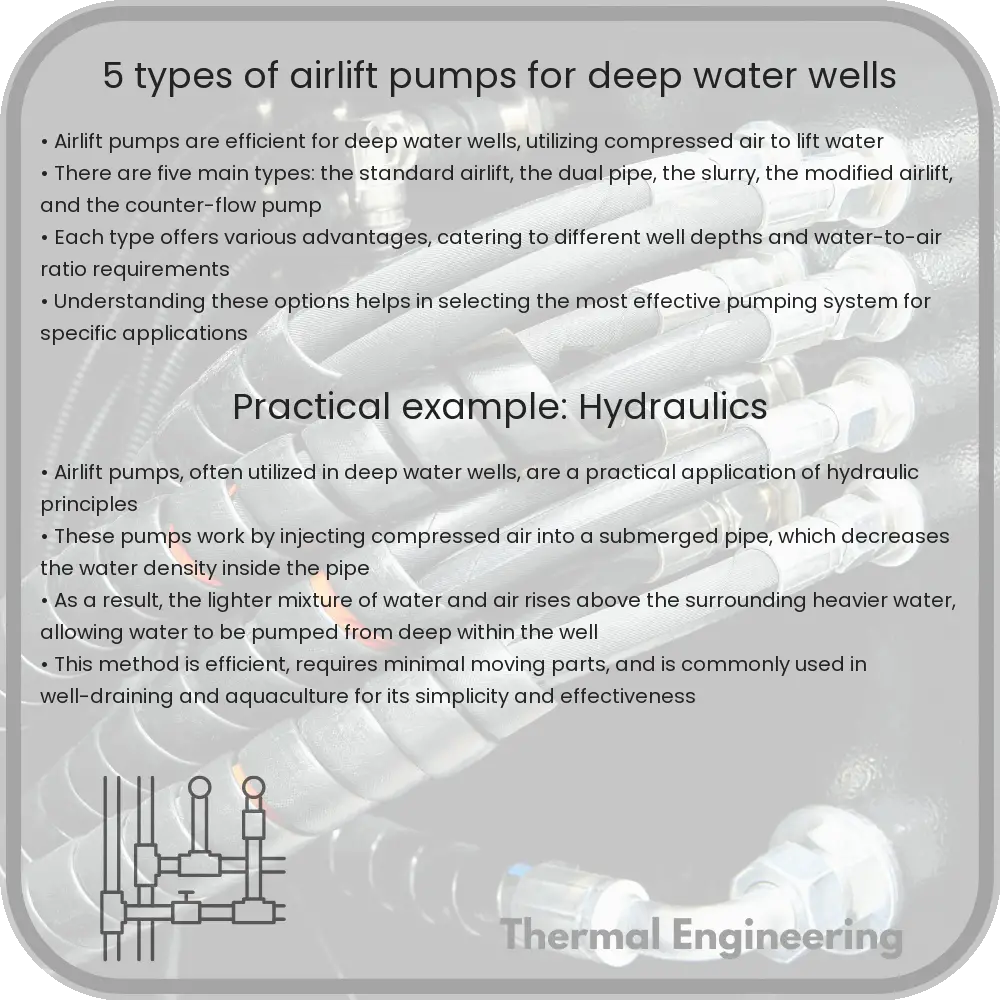Learn about airlift pumps, innovative devices using air to elevate water and fluids in various applications, from deep wells to geothermal extraction.

Introduction to Airlift Pumps
An airlift pump is a type of pump that uses air to lift water or other fluids. It consists of a pipe, an air compressor, and sometimes an air release system. Air is injected into the lower end of the pipe submerged in fluid. The air bubbles mix with the fluid, reducing its overall density. As a result, the lighter mixture of air and fluid rises through the pipe to the surface. Airlift pumps are commonly used in deep water wells because they are simple, have no moving parts below the surface, and are resistant to a variety of well conditions.
1. Simple Airlift Pumps
Simple airlift pumps are the most basic form used in deep water wells. They consist of a single, long pipe that extends into the water source, with an air compressor attached to introduce air at the base of the pipe. The setup is straightforward but requires effective depth and air pressure to function correctly. These pumps are particularly suitable for water well applications where electrical energy and maintenance capabilities are limited.
2. Dual-Pipe Airlift Systems
In a dual-pipe airlift system, two concentric pipes are used. Air is injected through the annular space between the smaller inner pipe and the larger outer pipe, and water is drawn up through the inner pipe. This setup typically offers better efficiency than the simple airlift system, particularly in deeper or larger-diameter wells. It provides more control over the air and water flow compared to the single-pipe configuration.
3. Counterflow Airlift Pumps
Counterflow airlift pumps are designed so the flow of air is opposite to the flow of water. This design can enhance the efficiency by improving the air-water contact and ensuring a more homogenous mixture of air and fluid. These pumps often require more precise fabrication and more careful control of air flow, and they are less common than simple or dual-pipe systems.
4. Slimhole Airlift Systems
Slimhole airlift systems are designed for applications involving narrow-bore wells. These systems use smaller pipes that are more delicate and require precise calibration of air volume and pressure. Despite these requirements, slimhole systems are advantageous in environments where larger traditional airlift setups cannot be accommodated or where the aesthetic impact must be minimized.
5. Geothermal Airlift Pumps
Geothermal airlift pumps are specialized for use in geothermal wells, where hot water or steam from below the Earth’s surface needs to be brought to the surface. These pumps must withstand high temperatures and chemically aggressive fluids. Furthermore, the operation of these pumps often needs to accommodate significant variations in fluid consistency and temperature, requiring robust design and frequently advanced materials.
Conclusion
Airlift pumps serve as an effective and often economical choice for deep water well applications due to their simplicity and robustness. Each type of airlift pump is designed to meet specific conditions and challenges, offering flexibility across various applications. Whether for basic water extraction or for specific needs like in geothermal extraction, understanding the types of airlift pumps helps in selecting the most appropriate technology for effective fluid lifting.